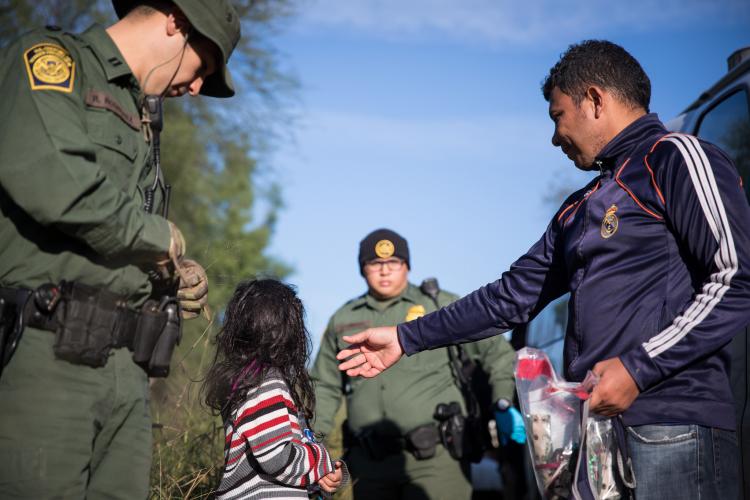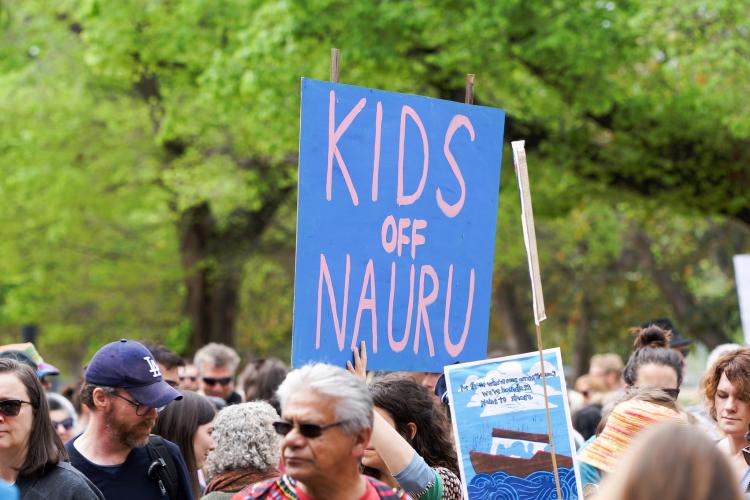You are here
Children on the Frontlines

An Afghan mother and child sleep in the woods after crossing the border from Turkey into Greece. (Photo: Mathias Depardon/UNHCR)
Hardline policies in the United States and Australia toward migrants and asylum seekers in 2018 hit turbulence when their effects on the most vulnerable—young children—provoked widespread public revulsion and prompted a retreat, at least temporarily. In Europe, conditions for children in the Moria refugee camp in Greece and the return by European governments of failed asylum seekers, including children, to an increasingly unstable Afghanistan also drew condemnation, though did not provoke policy reversal.
|
Issue No. 4 of Top Ten of 2018 |
In one of the most powerful images of the Syrian conflict and resulting refugee crisis, the photo beamed around the world of 3-year-old Alan Kurdi’s body, washed up on a Turkish shore in 2015, not only shook public consciousness but spurred the United Kingdom and Canada to increase their humanitarian protection commitments. Whether similar photos widely circulated in 2018—of Jakelin Caal, the 7-year-old Guatemalan girl who died while in U.S. Border Patrol custody, and of a mother tugging her twin daughters away from tear gas fired by border agents at migrants approaching the California-Mexico border—will have any effect on U.S. policy is too soon to tell.
Still it seems clear that Western publics, swamped with round-the-clock news about immigration in ways not seen even a few years ago, respond viscerally when government policies touch the youngest, most vulnerable populations.

Child and her family after crossing the Rio Grande River in McAllen, Texas, 2018. (Photo:Ozzy Trevino/U.S. Customs and Border Protection)
Family Separation in the United States
More than 2,600 children were separated from their parents between April and June 2018, as the Trump administration implemented a zero-tolerance policy to prosecute adult migrants crossing the U.S.-Mexico border illegally. After huge public outcry and intense media coverage, including accounts by nursing mothers that their babies were taken from them, President Trump rescinded the family separation policy in June. A federal court later stepped in, ordering the government to reunite parents, some of whom had already been deported, with their children. As of early November, nearly 150 children remained separated.
The administration continues to separate families in a small number of cases and has said it could reinstate the broader policy amid a spike in arrivals of Central Americans.
Separately, the administration is facing significant attention over its decision to build a tent camp in the Texas desert to house as many as 3,800 teens who entered the United States unaccompanied. Though the Tornillo camp was meant to be a short-term solution, it now has no end date in sight. And the number of children being held there is swelling as family members in the United States and other sponsors are reluctant to come forward to claim custody amid heightened administration vetting of their status. A record 14,000 migrant children, the vast majority unaccompanied minors, are now in the custody of the federal Office of Refugee Resettlement (ORR), which is responsible for the Tornillo camp and other facilities where child migrants—including those separated from their families—are being held. A delegation of congressional Democrats recently demanded the camp’s closure. (For more on the administration's actions at the border, see Issue #3: Shaping a Narrative of "Crisis" at Border, Trump Administration Takes Muscular Action.)

Sign at the Children's March for Nauru in October 2018. (Photo: ant/Flickr)
Australia and the Children on Nauru
Across the world, Australia bowed in October to long-standing domestic and international criticism of its treatment of asylum seekers, agreeing to relocate all refugee and asylum-seeker children kept on the island of Nauru. Their long-term futures, however, remain unclear.
Human-rights organizations and the Australian government itself have long documented terrible detention conditions that have resulted in children as young as 10 attempting suicide, engaging in other self-harm, or succumbing to resignation syndrome. Earlier this year, nearly 6,000 doctors delivered a letter to Prime Minister Scott Morrison calling for the end of child detention.
Australia’s hardline policy began in 2013, when it started sending asylum seekers attempting to reach the country by boat to offshore processing centers on Nauru and Manus in Papua New Guinea. Amid efforts by the Labor Party to pass laws allowing the medical evacuation of children and families from Nauru, Morrison recently accused Labor of siding with people smugglers and weakening national security.
What’s Next?
While Australian and U.S. policy towards migrant and asylum seeker children has evolved, at least for now, elsewhere reports of harsh conditions have not resulted in policy change. Despite widespread condemnation of the dire conditions facing approximately 3,000 children kept in the Moria refugee camp on the Greek island of Lesvos, there is no plan to move them, amid continued European wrangling over an equitable formula for distributing asylum seekers among EU Member States. And these governments are continuing to return failed asylum seekers, including children, to Afghanistan, as part of a greater European policy focus on returns. (For more on Afghan returns, see Issue #6: Intensifying Focus on Migrant Returns Takes a More Global Stage.)
In an era where any discussion of migration, it seems, is immediately highly polarized, the effects of policy on children throw into sharp relief the actual impacts of decisions taken in far-off capitals. But even amid widespread sympathy for the plight of children, the intractable nature of the migration challenges surrounding their movement and the lack of easy solutions mean recognition of their unique status does not always lead to policy change.
Recommended Resources
- Affording Congress an Opportunity to Address Family Separation, Executive Order signed by President Trump, June 20, 2018
- Special Review: Initial Observations Regarding Family Separation Issues under the Zero Tolerance Policy, Department of Homeland Security, Office of the Inspector General
- ‘Zero Tolerance’ Immigration Policy Surprised Agencies, Report Finds, The New York Times
- The Chaos Behind Donald Trump’s Policy of Family Separation at the Border, 60 Minutes
- Child Trauma on Nauru – The Facts, Asylum Seeker Resource Center
- UNHCR Appeals to Australia to Act and Save Lives at Immediate Risk, UNHCR press release
- From Europe to Afghanistan: Experiences of Child Returnees, Save the Children
- "The Worst Refugee Camp on Earth," BBC News video


